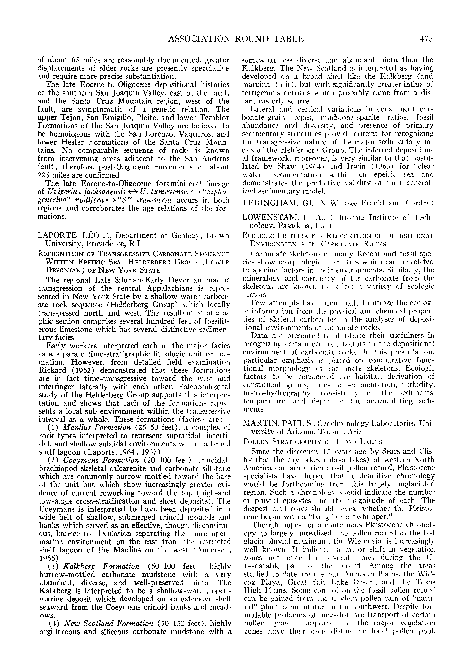Academia.edu no longer supports Internet Explorer.
To browse Academia.edu and the wider internet faster and more securely, please take a few seconds to upgrade your browser.
Recognition of Transgressive Carbonate Sequence Within Epeiric Sea: Helderberg Group (Lower Devonian) of New York State: ABSTRACT
Recognition of Transgressive Carbonate Sequence Within Epeiric Sea: Helderberg Group (Lower Devonian) of New York State: ABSTRACT
1967, AAPG Bulletin
Related Papers
1967 •
Journal of Sedimentary Research
Control of terrestrial stabilization on Late Devonian palustrine carbonate deposition; Catskill Magnafacies, New York, U.S.A1999 •
2002 •
1987 •
Palaeogeography, Palaeoclimatology, Palaeoecology
Revised correlation of the Frasnian–Famennian boundary and Kellwasser Events (Upper Devonian) in shallow marine paleoenvironments of New York State2015 •
RELATED PAPERS
Journal of Late Antiquity
An Exceptional Late Antique Belt-Buckle Plate from Jaffa: From Metalworking Technology to Cultural Biography2024 •
LA HISTORIA OLVIDADA: FILIPINAS-MEXICO 2024
The Domestication of Asia Trans-Pacific Art Objects in 17th Century New Spain2024 •
Huerta, R. (2023). Artivismo y creatividad en la formación docente: cementerios, arte y literatura. Arte y Políticas de Identidad, 29, 65–86. https://doi.org/10.6018/reapi.598721
Artivismo y creatividad en la formación docente: cementerios, arte y literatura2023 •
North East Journal of Legal Studies
OVERCOMING COGNITIVE BIASES: THE KEY TO REDUCING BIGOTRY AND VICTIMIZATION2024 •
TÜRK YURDU DERGİSİ
TOPONOMİDEN EFSANEYE, EFSANEDEN HALK ETİMOLOJİSİNE DİVANÜ LUGAT'İT TÜRK2024 •
In: Nataliya Levkovych, ed. Diversity in Contact. Berlin: De Gruyter, 3-90.
Differential impact of colonial languages on written languages: A case study from Latvia in the early 19th century.2023 •
Gorur Radhika, Landri Paolo and Normand Romuald (eds.) Rethinking Sociological Critique in Contemporary Education. Reflexive Dialogue and Prospective Inquiry
Evaluation through Regimes of Engagement and Grammars of Commonality Critical Tensions in Community- and Self-Formation – An Interview with Laurent Thévenot2023 •
Geographia Opportuno Tempore
A HERANÇA ESCRAVOCRATA NA SEGURANÇA PÚBLICA NO BRASIL2018 •
Aspettando Godot: Πόλεμος Πατέρας Πάντων
Χατζηδημητρίου, Aspettando Godot, Κριτική θεάτρου Parallaxi 29/5/20242024 •
The Annals of Thoracic Surgery
Bilateral Lung Transplantation From a Donor With Heparin-Induced Thrombocytopenia2015 •
International Journal of Electrical and Computer Engineering (IJECE)
Energy cost savings based on the UPS2020 •
2021 •
British Journal of Haematology
Thrombolysis restores perfusion in COVID‐19 hypoxia2020 •
Journal of Clinical Microbiology
Toward Universal Varicella-Zoster Virus (VZV) Genotyping: Diversity of VZV Strains from France and Spain2006 •
Lisjan Tushaj
RESHAPING URBANITY THROUGH ELABORATED URBAN RE-GENERATION TOOLS. INTERNATIONAL CASE STUDIES2019 •
Journal of the knowledge economy
Rethinking of Government Institutions and Governance Quality Indicators on Economic Growth in Sub-Saharan African Countries2024 •
Physics Letters B
Measurement of the atmospheric muon spectrum from 20 to 3000 GeV2004 •
RELATED TOPICS
- Find new research papers in:
- Physics
- Chemistry
- Biology
- Health Sciences
- Ecology
- Earth Sciences
- Cognitive Science
- Mathematics
- Computer Science
